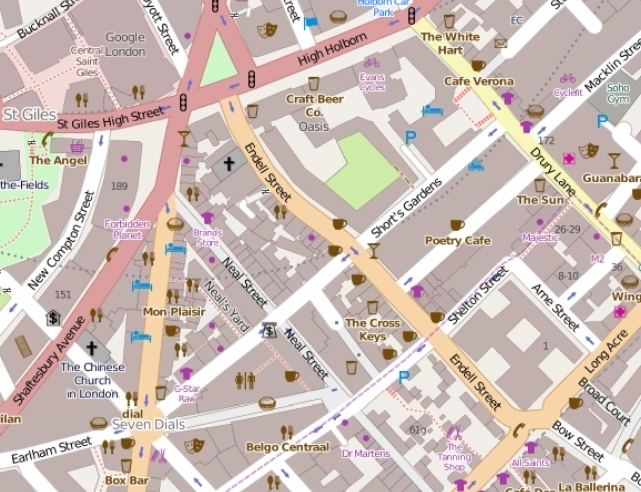Major cities London | ||
 | ||
Rentlondonflat com 2 beds 2 baths endell street covent garden wc2
Endell Street, originally known as Belton Street, is a street in London's West End that runs from High Holborn in the north to Long Acre and Bow Street, Covent Garden, in the south. It now forms the entire B401, which originally included Bow Street and Wellington Street.
Contents
- Rentlondonflat com 2 beds 2 baths endell street covent garden wc2
- Map of Endell St London WC2H 9AJ UK
- Endell street easter gig 2010
- Location
- History
- Listed buildings
- Lavers and Barraud stained glass studio
- Cross Keys public house
- Latchfords Timber Yard
- Swiss Protestant Church
- Inhabitants
- Endell Street Military Hospital
- St Pauls Hospital
- Clubs
- The Caravan Club
- The Hospital Club
- References
Map of Endell St, London WC2H 9AJ, UK
Endell street easter gig 2010
Location
Endell Street is crossed only by Shorts Gardens and Shelton Street. Betterton Street adjoins Endell Street between the two on the eastern side. The northern end of the street is in the London Borough of Camden, the south in the City of Westminster.
History
The land on which the southern part of Endell Street is built was originally owned by William Short, who leased it to Esmé Stewart, 3rd Duke of Lennox, in 1623–24. Lennox House was built on the site which eventually passed to Sir John Brownlow who began to build from 1682. Belton Street was created, named after the Brownlow's country seat in Lincolnshire, Belton House. Henry Wheatley writes that the southern end of the street from Castle Street to Short's Gardens was originally known as Old Belton Street, the northern end from Short's Gardens to St Giles, was known as New Belton Street.
In the seventeenth century, Queen Anne is supposed to have bathed in the waters from a medical spring there at a site known as Queen Anne's Bath.
The modern Endell Street was created according to the reforming plans of architect James Pennethorne.
Charles Lethbridge Kingsford states that the street was built in 1846 when Belton Street was widened and extended northwards to Broad Street (now in High Holborn). The street is believed to have been named after the Reverend James Endell Tyler, rector of St Giles in the Fields in the 1840s. The British Lying-In Hospital was relocated to a purpose-built building on Endell Street in 1849.
Listed buildings
There are eight listed buildings in Endell Street, including:
Lavers and Barraud stained glass studio
The Lavers and Barraud stained glass studio and railings at number 22, designed by R.J. Withers in Gothic style 1859, is a Grade II listed building.
Cross Keys public house
The Cross Keys public house at number 31, constructed 1848-49, is a Grade II listed building.
Latchfords Timber Yard
The nineteenth century Latchfords Timber Yard and attached timber sheds at number 61 are Grade II listed.
Swiss Protestant Church
The Swiss Protestant Church at number 79, was designed by George Vulliamy and built 1853-4. It is Grade II listed.
Inhabitants
The watercolour painter William Henry Hunt was born at 8 Old Belton Street (7 Endell Street) in 1790.
Endell Street Military Hospital
During the first world war a military hospital operated from Endell Street, staffed entirely by women. The hospital was opened in 1915 by suffragists Dr Flora Murray and Dr Louisa Garrett Anderson and treated 24,000 patients and carried out over 7,000 operations. It closed in 1919. The hospital was sited on land formerly used as the St Giles Union Workhouse.
St Paul's Hospital
St Paul's Hospital relocated from Red Lion Square to 24 Endell Street in 1923. It became the first artificial kidney unit in the United Kingdom in 1959 and performed the first kidney dialysis in the U.K. in 1961. The building is now The Hospital Club.
Clubs
Endell Street has been the home to several clubs.
The Caravan Club
The basement of number 81 was home from July 1934 to the Caravan Club that advertised itself as "London's Greatest Bohemian Rendezvous said to be the most unconventional spot in town" which was code for being gay-friendly. The club helpfully promised "All night gaiety". It was run by Jack Rudolph Neaves, known as "Iron Foot Jack" on account of the metal leg brace he wore, and was frequented by both gay men and lesbian women. It was financed by small-time criminal Billy Reynolds. The club came to the attention of the police almost straight away and in August local residents complained "It's absolutely a sink of iniquity". The club was raided on 25 August and a number of men arrested. Their subsequent trial locally at Bow Street Magistrates Court caused a sensation reported in the News of the World.
The Hospital Club
The Hospital Club opened in 2003 at number 24 to serve the members of London's media and creative industries. It is on the site of the former St Paul's Hospital.
